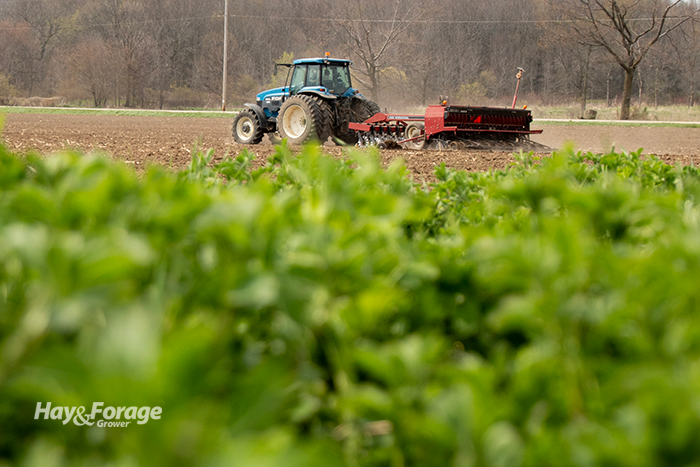
Everyone has their opinions on how to best seed cool-season grasses and legumes for successful establishment. Variables include factors such as planting rate, type of drill or seeder, weed control method, companion crop (or not), and seeding time. It’s this last factor we will focus on here.
In many regions, late-summer and fall seedings are the norm and preferred time for forage establishment. If you’re in that camp, this article won’t be of much interest. However, if you find yourself with seed to still put in the ground this year, the question being answered here is “How late is too late?”
Every state has their recommended seeding date range for establishing cool-season forage species in the spring. There are even “drop-dead” dates established by USDA’s Risk Management Agency whereby they will no longer insure new seedings. These dates have all been established for good reasons, mostly to maximize the odds of a successful establishment outcome.
When I worked as an extension agent, I recall being responsible to get alfalfa plots (with grass borders) seeded for a large farm show that was going to be held in our county the following year. As the spring wore on, ground conditions went from wet to wetter. During the few times there was a seeding window, I couldn’t get a drill because the owner was still trying to get his plots planted.
On the Sunday morning of Father’s Day, I got a call that we could seed if I wanted to. I checked the weather forecast, and, of course, there was rain predicted for the following week. That meant it would be bad to wait but good to get the new seeding germinated. We went ahead and spent that Father’s Day seeding alfalfa and grass.
As it turned out, rain continued throughout the establishment phase, and it was some of the best-looking alfalfa in the area. The warmer temperatures only amplified the growth. I also found myself mowing the grass borders on a weekly basis for the remainder of the summer.
I relate this story only to point out that cool-season forages can be planted about any time and be successful. Over the years, I became more prone to offer my blessing to farmers who would call and ask if it was too late to seed in June. The only exception was if conditions were dry and future rainfall was nowhere in sight. Seeding late can work, but you must have moisture.
We typically like to seed cool-season forage species early because they germinate at relatively cool soil temperatures, they can get ahead of the weed flush that comes later, moisture is usually a nonissue, and total-season forage yields are enhanced. There is also a lower risk for hard thunderstorms that can wash seedings away or cause severe soil crusting and erosion.
For sure, late is riskier
With late seedings, we can flip all those advantages into risk factors. The primary one is the better odds for hot, dry soil conditions. What we don’t want to happen is to get a little rain, germinate the seed, and then have the seedbed turn to dust. That is a forage seeding’s apocalypse.
Weeds can be an issue with later plantings; however, there are viable herbicide options, especially for pure alfalfa seedings. Glyphosate resistant varieties make weed control for alfalfa relatively easy with little risk of crop injury. Of course, there are other good herbicide options as well.
When seeding alfalfa and grasses together, weed control must be taken into consideration before leaping into a late planting. It could be a deal breaker if weed competition is expected to be a problem. Seeding-year forage yield, for any type of planting, will generally be reduced for delayed plantings compared to earlier seedings.
If weeds aren’t a particular concern or can be dealt with, soil moisture is really the only limiting factor for a successful late seeding. Soils dry out more quickly as temperatures warm. One thing to keep in mind is that because soils are warmer, seedling emergence and growth are much faster with a late seeding date. Cold- and wet-soil seedling diseases may also be less of a problem.
Planned or not, there are bigger risks we can take in a forage production enterprise than seeding into early summer. Although it may not be wise in every situation, don’t get too alarmed if the normal “drop-dead” seeding date passes by.

